Sunrise Reveals the Many Wonders of the Angkor Wat Temple
Our travels in Cambodia included one particularly early morning, as we rose at 4:30 to view the sunrise at Angkor Wat. It was about a 20-minute trip in the dark. Upon arrival the dark continued to slow our travelling as we found it a little tricky navigating the uneven stones on the walkway over the moat that surrounded Angkor Wat.
The early morning air was warm and thick as we jockeyed for a good position to capture the first rays of the sun. Our guide was good enough to point us to an area with a lesser view, but also fewer people so that we were able to get very close to the edge of the water. Then the waiting began.
It was about 5:45 when we got settled and the sun didn’t rise until 6:30. Even with the crowd around us it was eerily quiet as if everyone here knew what a special place this was.
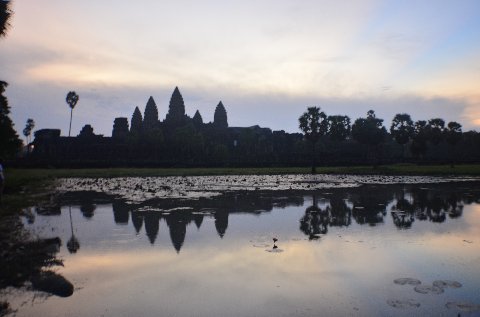
Angkor Wat translates to “Temple City” and was built in the early 12th century by the Khmer King Suryavarman II. Unlike earlier temples in the area, it was a Hindu temple dedicated to Vishnu and served as the king’s state temple and capital city. As no foundation stela or contemporary inscriptions have been found it’s not possible to completely ascertain the original name. The walls and galleries are covered with bas-relief decoration depicting episodes of Hindu epics.
One of the most interesting facts about the complex is that the huge sandstone blocks were polished smooth as marble and tightly fitted together; sometimes using mortise and tenon joints, while others were put together with dovetails and gravity. It is difficult to put the beauty and aura of this place into words, so I can only hope that our photos do it justice.
Once the sun was up we moved closer to the buildings and saw that the center of attention was a resident monkey who was apparently quite adept at begging for food.
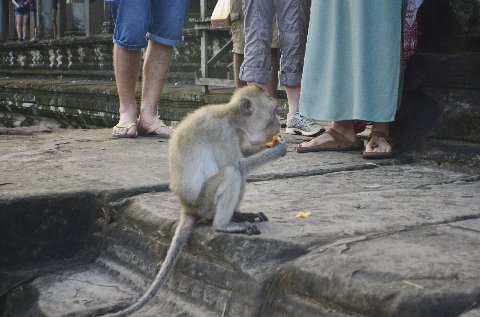
As we began to walk down the first colonnade and into the complex, we started to see many carvings and reminders of this ancient civilization.


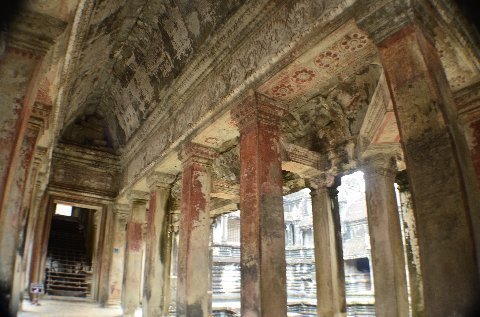


Climbing to the second level and arriving in a courtyard we saw the entrance steps the king used to reach the third level of the temple. They were steep but not nearly as high as the ones the regular people had to use. Almost all the buildings are covered in black mold which is not surprising given the incredibly humid climate.



As we walked among the ruins, our guide provided some greater history on the temple. Twenty seven years after the death of Suryavarman II, in 1177 Angkor was attacked by the Chams, traditional enemies of the Khmer. Later the empire was restored by a new king, Jayavarman VII who moved the capital to nearby Angkor Thom and Bayon. In the 13th century Angkor Wat moved from Hinduism to a form of Buddhism and although in later centuries it was neglected to the point of being partially reclaimed by the jungle, it was never completely abandoned. Throughout history, parts of the temple were used continuously by visiting monks and religious, so that part of the structure was still visible. In contemporary times it was visited by a Frenchman, Henri Mouhot, who spread the word of his discovery. In the 20th century there was much work done to clear the dirt and vegetation that had grown around the temple. Unfortunately, this was halted by the unrest and wars of the 1970s and 80s but little damage was done other than the thefts of post-Angkorian art.
After we had walked through the temple we continued on to the back where a set of wooden steps had been constructed so visitors could climb to the top level. These were almost as steep as a ladder but we were determined.

From the top we could look out to the surrounding moat and entrances.
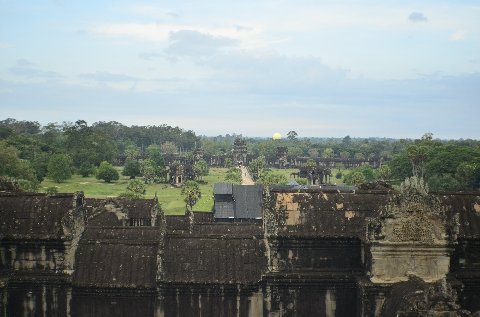
By the time we finished the tour it was about 9:00 and time for a little breakfast. Our driver picked us up and we drove to a small park where boats were bobbing in the water of the moat around Angkor Thom. We stepped gingerly onto a “gondola” where we found coffee, tea, fresh fruit, yogurt and a selection of breads provided by the hotel, which we enjoyed while cruising along the canal. A young boy energetically rowed us along the deserted waterway and we enjoyed the quiet of the morning after the crowds at Angkor Wat.
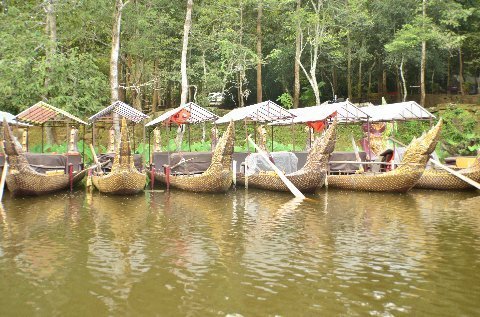
The solitude was only temporarily broken by a group of young boys and their dog crossing to a camp on the other shore, and some local women out in a canoe cutting lotus blossoms.

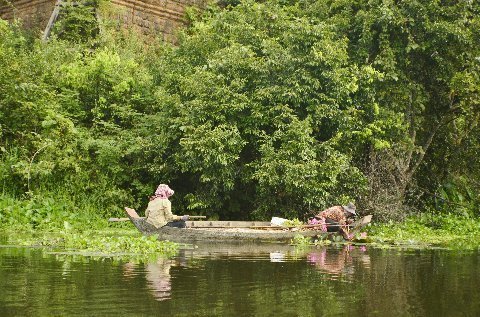
Ready to learn more?
Determine whether life aboard The World is the right fit for you. Talk to one of our Residential Advisors today to learn more about this unique lifestyle, details of upcoming Journeys and Expeditions, and ownership opportunities.



